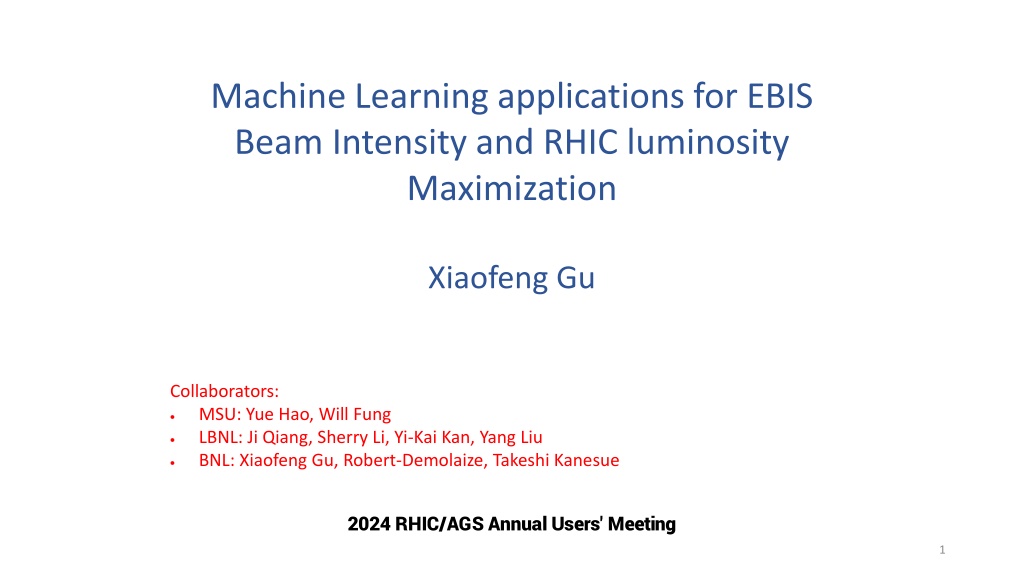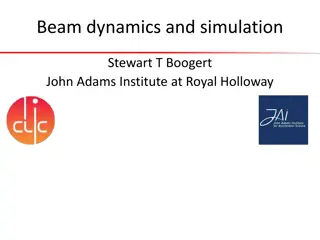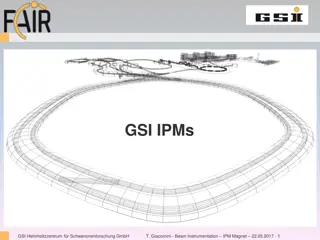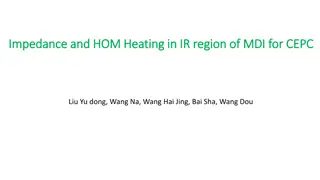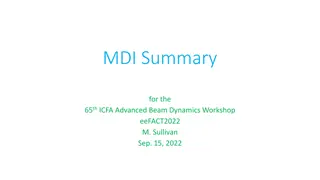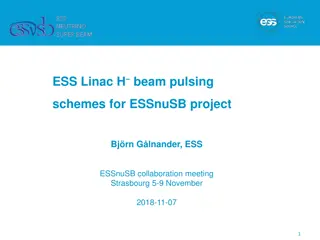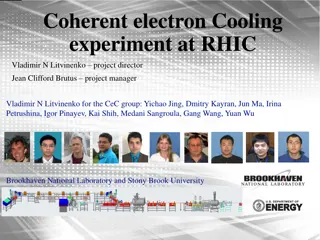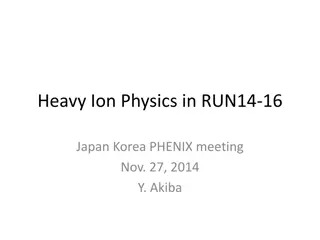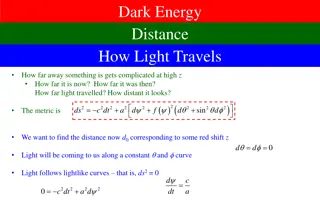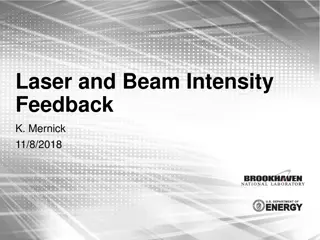Machine Learning Applications for EBIS Beam Intensity and RHIC Luminosity Maximization
This presentation discusses the application of machine learning for optimizing EBIS beam intensity and RHIC luminosity. It covers topics such as motivation, EBIS beam intensity optimization, luminosity optimization, and outlines the plan and summary of the project. Collaborators from MSU, LBNL, and BNL are involved in maximizing beam intensity and luminosity for the RHIC complex. The use of tools like GPTune and XGBoost for online optimization and offline analysis is highlighted, along with the focus on sPHENIX luminosity optimization at RHIC. Bayesian optimization at LBNL through GPTune is also explored for multi-objective tuning. The presentation delves into maximizing the useful signal within VTX while minimizing unwanted signals and utilizing historical performance databases for optimization.
Download Presentation

Please find below an Image/Link to download the presentation.
The content on the website is provided AS IS for your information and personal use only. It may not be sold, licensed, or shared on other websites without obtaining consent from the author. Download presentation by click this link. If you encounter any issues during the download, it is possible that the publisher has removed the file from their server.
E N D
Presentation Transcript
Machine Learning applications for EBIS Beam Intensity and RHIC luminosity Maximization Xiaofeng Gu Collaborators: MSU: Yue Hao, Will Fung LBNL: Ji Qiang, Sherry Li, Yi-Kai Kan, Yang Liu BNL: Xiaofeng Gu, Robert-Demolaize, Takeshi Kanesue 2024 RHIC/AGS Annual Users' Meeting 1
Outline: 1) Motivation 2) EBIS Beam Intensity Optimization 3) Luminosity Optimization 4) Plan & Summary 2
1) RHIC Complex Beam Optimization Intensity, emittance and polarization ltb Ion Source: EBIS bta Proton Source: OPPIS 3
1) sPHENIX luminosity Optimization (RHIC) sPHENIX: 1. max. MVTX (+/-10 cm) 2. min. unwanted signal 3. Crossing angle (2mrad) ?1?2?? ? = 2+ ??2 2 2+ ??2 2 2? ??1 ??2 Global Parameters: 1. Orbit (Dipole) 2. Tune (Quadrupole), 3. Chromaticity (Sextuple) 4. Octupole Maximize minimize Local (IR8) Parameters: 1. Beta* (beam size) 2. S* (longitudinal beam waist) 3. Transverse offset Jamie Nagle, 06/04 1. Many variables; 2. Maximize the useful signal within VTX while minimize the unwanted signal outside of VTX 3. Machine learning could be a good tool for a fast, multi-objects tunning. 4. GPTune will be used for ONLINE optimization, XGBoost for offline analysis. Other Parameters: 1. RF Voltage 2. Collimator Position 4
Outline: 1) Motivation 2) EBIS Intensity Optimization 3) Luminosity Optimization 4) Plan & Summary 5
2) Bayesian optimization at LBNL GPTune Several features of GPTune (BLNL) are very useful, including: (1) relies on dynamic process management for running applications with varying core counts and GPUs (2) can incorporate coarse performance models to improve the surrogate model (3) allows multi-objective tuning such as tuning a hybrid of computation, memory and communication. (4) allows multi-fidelity tuning to better utilize the limited resource budget 1. Many variables; 2. Maximize the useful signal within VTX while minimize the unwanted signal outside of VTX. (5) supports checkpoints and reuse of historical performance database. https://github.com/gptune/ 6
2) GPTune Test: EBIS Intensity Optimization fc96 LION 1 RFQ LINAC 2 6 8 4 5 7 3 EBIS xf14 Buncher2 Buncher1 Buncher3 Injection [fc96] Extraction [xf14] 9 1. LION 2. EBIS Injection Line (fc96) 3. EBIS 4. EBIS Extraction line (xf14) 5. RFQ 6. MEBT 7. Linac 8. HEBT 10 IonLens20-40kV DeflPlatBias 16PoleX 16PoleY Gridded_Lens Horiz_Bend_Defl Inter_Vert_Defl Inter_Vert_Defl_Lower Horiz_Sphere_Bend RFQ_Horiz_Bend LEBT_Solenoid Total Variables 1 2 3 4 5 6 7 8 9 10 11 7
2) GPTune: EBIS Injection Line (9 parameters) ~14.0 11.5 fc96 Intensity ~22% improvement after optimization script was running from 12:33 to 13:36 (~63 min) 1 beam / supercycle [6.6 s]; it takes 2 supercycles for the powers settle down;4 supercycles for measurement. fc96 measurement was used for injection optimization 8 9 control parameters after 70 iterations
2) GPTune: EBIS Extraction Line (10 parameters) ~2.0 Xf14 Intensity 1.4 ~43% improvement after optimization script was running from 10:18 to 11:15 (~57 min) 2 beam / supercycle [6.6 s]. xf14 measurement was used for extraction optimization. 10 control parameters after 60 iterations 9
2) GPTune: EBIS Intensity Gain (11/25/2023) 13.67 1.40 13.89 1.76 12.16 1.23 11.22 1.05 Beam Intensity [uVs] Inj+Ext. Original. Inj+Ext. Ext. Original, Ext., Inj. + Ext.: use the saved parameters for these beam lines. 2.53 0.20 2.49 0.24 2.23 0.17 GPTune works with std 10% (pp 15% ) noisy signals! 1.48 0.13 Possible more gain with fc96 instead of xf14 for the extraction line? Time 10
2) GPTune: EBIS Injection + Extraction (19 parameters) Continue to optimize the total 19 parameters simultaneously AFTER optimizing the injection and extraction separately. Fc96 was used. After optimization, the results were compared via reversing their corresponding settings. Original setting: 22 [uVs] 80-iterations setting: 23 [uVs] 90-iterations setting: 23.56 [uVs] (7%) 1.07 1.22 ~ 1.30 ? 90 iterations 80 iterations Original Beam Intensity [uVs] Time 11
2) Offline XGBoost Model and Important Features The models achieved scores of 79% and 80% for the injection and extraction beam lines. Motivations (guide operation): 1. Find some most important parameters 2. Find their operation range. 3. Explore different operation region. XGBoost python package: Multi-dimensions nonlinear regression algorithm: good for f(x1,x2,x3, , xn) with n>3 or 4. (Higgs Machine Learning Challenge) The black-box model: 80% data for training, 20% data for test and comparison How to explanate the black-box model? Important Parameters SHAP python package: an approach to explain the output of any machine learning black-box model via calculating their Shapley values (marginal effect), which are their contributions to the total luminosity. Separate the individual effect. 12
2) SHAP Plot: Prediction for Operation Range Operation range Explore range?! 13
Outline: 1) Motivation 2) EBIS Intensity Optimization 3) Luminosity Optimization 4) Plan & Summary 14
3) GPTune Luminosity Optimization-Analytical Model Unwanted Lumi Maximize minimize Unwanted Vertex signal ( 10cm) The value of the objective function is minimized. 15
3) GPTune Luminosity Optimization-Simulation The value of the objective function is minimized The optimization of the lattice setting with respect to the luminosity is performed for the head-on collision of two Au-Au beams in the Relativistic Heavy Ion Collider (RHIC). The parameters of the lattice setting with only two variables ??? and ???. The value of the objective function converges when more optimization steps are executed. This implies the value of the objective function is minimized and hence the total luminosity ??is maximized. 16
3) GPTune luminosity Optimization sPHENIX Global Parameters: 1. Orbit (Dipole) 2. Tune (Quadrupole), 3. Chromaticity (Sextuple) 4. Octupole Optimization method Luminosity Measurement Machine parameters MVTX ZDC GPTune Local (IR8) Parameters: 1. Beta* (beam size) 2. S* (longitudinal beam waist) 3. Transverse offset S* Other Parameters: 1. RF Voltage 2. Collimator Position S* and beta* changing scripts: 2023 1. change the target s*, beta* within deltas.dat file; 2. run madx job.madx command, will get IP8knob.dat file; 3. run CreateSend.IP8 command, will get SendTrim.IP8 file; 4. run SendTrim.IP8 command. GPTune: 2023 1. Installed and tested 2. Did some optimizations EBIS and got some good results. Optimization Loop: May, 2024 sPHENIX (OFF): 1. max. MVTX (+/-10 cm) 2. min. unwanted signal 3. Crossing angle (2mrad) 4. ZDC rate 17
3) The First sPhenix ZDC Optimization 05/16/2024 S*: +/-0.5 m without decay compensation Blue Beam Loss S*: +/-0.5 m; +/-0.1 m. S*(x plane): 0.74-0.76m; 0.8m->0.4m->0m->-0.4m- >-0.8m. S* > 0.8 m, MADX didn t find solutions. +/-0.5 m +/-0.5 m +/-0.1 m 0.74-0.76m GPTune Signal Beam loss is acceptable. 0.8 to -0.8m ZDC rate was changed. Didn t see any visible improvement with 10% pp noise. sPhenix ZDC rate With +/- 0.8m, it is expected 17% change for ZDC rate. GPTune works with std 10% (pp) noisy signals 15%! 18
Outline: 1) Motivation 2) EBIS Intensity Optimization 3) Luminosity Optimization 4) Plan & Summary 19
4) Reasons and Plan for Luminosity Optimization Global Parameters: 1. Orbit (Dipole) 2. Tune (Quadrupole), 3. Chromaticity (Sextuple) 4. Octupole S* control: 1. S* measurement to confirm Base line: s*x = 1.19m, s*y = 0.67m Move s*x -> -0.5 m: s*x = 1.14m, s*y = 0.01 Move s*x -> 0.5 m: s*x = 0.74m, s*y = 0.35 2. Using Power supplies instead of S* 3. Control Power supplies only ramp to one direction Local (IR8) Parameters: 1. Beta* (beam size) 2. S* (longitudinal beam waist) 3. Transverse offset S* Measurement: lattice and real machine 4. Improve Emittance: Done Magnet hysteresis: Same current can have different field (up or down ramp) 5. Explore other control parameters? Other Parameters: 1. RF Voltage 2. Collimator Position Too large beam size: the emittance was 3~4 higher than nominal. 6. Optimize Luminosity vs Reduce background? Optimal S* already: is very closed to its optimal and don t need to do anything! 7. sPHENIX detector or MVTX signal were OFF.
4) RHIC Complex Anomaly Detection (Plan) Gregory Marr 21
4) Summary 1. GPTune was used for EBIS intensity optimization and got 22~30% intensity improvement at xf14 CT (70% with fc96 CT) , with 10% std noisy signals and 19 variables. 2. The luminosity optimization with sPHENIX ZDC has been carried out for the first time. More APEX time is required to confirm the results or optimize the integral luminosity with more/different parameters. 3. GPTune has been demonstrated as a powerful tool for optimization. It is planned to be used for other beam lines (intensity, emittance and polarization) optimization in RHIC complex. 4. Some machine learning algorithms for machine anomaly detection are planned to used, to reduce RHIC complex fault time. 22
Acknowledgement R. Guillaume T. Kanesue M. Okamura J. Morris 23
